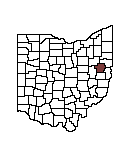County History as reported
in The Free Press Standard in 1933, page 4
County History Reveals Early State of Society
We have heretofore dwelt to some extent upon what the records show concerning the creation of the county, its first election and early settlement, interspersed by individual reminiscences, and as yet have said but little concerning the early state of society in Carroll-co, where we suppose did not differ very materially from that of the state at large in early days. What follows under this head we are indebted to Gen. Eckley who has already given it to the public not long since, yet a good thing will bar repeating, and with his permission we will not digress much from his notes.
"The life of an early pioneer was an unintermittent round of labor. Each day must add to the aggregate of its predecessors in felling the timber or pursuing the chase to keep the scanty larder from becoming empty. Their lives were so burdened with labor that their diversions , simple and rustic as they were, were inseparably connected with their daily toil. A newcomer's cabin is to be built, they gather for miles around, and the hills were made musical with the resounding echoes of their axes, each striving to out do his fellows in the hospitable effort to give their new neighbor a home. The day is one of such labor as would make their progeny of this day tremble at its contemplation. But it is only their ordinary daily exercise; ere night broods over them the cabin is complete -- taken from the stump, as it were, the logs adjusted, the clapboard roof put on, the puncheon floor laid, and yet some time to spend in shooting at mark, running races or jumping.
"The refreshments, hog and hominy, or maybe bear meat, venison or wild turkey -- accompanied by the never absent corncake, the whole invariably supplemented by the contents of the brow jug, are served in rudimentary style and dispatched with vigorous appetites.
"The wives and daughters have followed their husbands and brothers to the newcomer's clearing, and when too dark to sight along the rifle barrel, the housewarming begins. The fiddler, if the country is sufficiently advanced to boast of an instrument, resins his bow and gives a few admonitory strokes across the strings, when the merry couples fall in for the dance. The men in hunting shirts and homespun trousers, stuffed in the tops of cow-hide boots; the women in linsey dresses of their own weaving and making, join in the rivalry of the quickest step, the highest jump and liveliest shuffle. Fatigue was a stranger, and the merry revelers only quit when the dawn of the morning called them to the less poetic business of their daily life. A corn-husking, flax pulling, log rolling were the holiday amusements, which were always crowned by the shooting match or trial of athletic achievement and topped off with the all night dance. The activity of their lives was a sure preventative of sloth and languor and contributed largely to the formation and cultivation of those traits of character which so distinctly marked our ancestors."
First Still House
In spring of 1814, David Eakin moved into Brown-tp and settled upon the tract of land now occupied by Thomas J. McCobb, southeast of Oneida. There was a fine spring here, and a number of his neighbors suggested the idea of a distillery as a profitable investment, and accordingly a still house was erected next years. Whiskey was then active in the market at $1.50 per gallon. Liquor, during this early period in the settlement of the country, was kept as an article of entertainment in almost every family, and was always offered when friends or neighbors met. Indeed, not to set out the bottle when a neighbor called was regarded as an inhospitable demonstration, if not an intended insult.
Temperance Campaigns
The earliest temperance agitation was started about 1838, and from this time forward, the standard of temperance has been elevated on every spasmotic occasion; sometimes culminating in the organization of a lodge of Sons of Temperance, Good Templars or local temperance societies. About 1857 the Good Templars instituted the first Crusade against the liquor traffic. Women armed themselves with hatchets and went from one saloon to another, taking the barrels out on the sidewalks and bursting in the heads, allowing the contents to flow freely in the gutters. Many of the old citizens of Carrollton can remember when on one occasion the Sons of Temperance were parading the streets of the town at night, singing their songs of total abstinence, and how that a courier bringing in the election returns on horseback, ran over "Bill" Downs and broke his leg. The Women's Crusade of 1873-4 is still fresh in the minds of everyone, and was doubtless the entering wedge which lead to submitting the Second Amendment to the voters of the state. The Prohibition vote of Carroll-co placed her as one of the banner counties. The W. C. T. U. of this county is still at work, and with a persistence peculiar to their sex, must eventually succeed.
Shortly after the formation of this county, were the palmy days of general musters, which seems to have been the day set apart for settling up old scores and neighborhood feuds. Bloody noses and black eyes were sure to result from the meeting of so many men when whiskey flowed freely. The only benefit derived from these musters, so far as we have been able to learn, was the exemption of the participants from two days labor on the public highway.
Early School System
The rectangular survey of the state, by the government, into ranges, townships and sections; the XVI section of each township being set apart for school purposes, laid the ground work in an early school system to which we owe our present advancement. But the country was sparsely settled and the land very cheap in the early history of this county; so that schools were not so numerous nor even so well regulated as now. The following description of the first school house built in Brown-tp in 1812, and presided over by Edward Milner, will give a general idea of our institutions of learning in those days. The house was built of round logs, and was 16x18 feet square, with the joists so low that the larger scholars could readily lock their hands over them and swing to and fro. The house was totally destitute of glass and the only light enjoyed by the inmates came through paper greased and fastened in the opening made by cutting out a log on each side of the house. At the opposite end of the house from the door, the chimney was built of what was then called "cat and clay," which consisted of split wood and mortar. A wall of rough stone stood on edge and plastered over with mortar made of clay and straw, constituted the "backwall." The pupils in could weather gathered around the huge log fire and studied their lessons, by the light that came in through the greased paper, or that gleamed down the capacious flue, roasting on one side and freezing on the other.
The school masters of that day were, as a rule, aged, infirm, or crippled -- men not able to perform manual labor. Teaching was regarded as a very light occupation. If a healthy young man applied for a situation as teacher he was considered lazy and trifling. The American Primer, Dillworth's Spelling Book, Walsh's Arithmetic and the Bible constituted the class books of that day. Grammar and Geography were considered unnecessary and were very rarely introduced into the common schools, while philosophy, physiology, chemistry, music or painting were unheard of in connection with these primitive schools.
Geological Structure
;Carroll-co lies in the midst of the great bituminous coal region which stretches over a large part of eastern Ohio and the adjoining states, and it cannot be doubted that the development of its mineral sources is merely a question of time, and dependent mainly upon the future enterprise of its inhabitants. With some of the grandest scenery to be found within the boundaries of the state; with the best of markets, now within easy reach, and a full supply of working material, besides an abundance of mineral wealth, there seems to be no lack of everything calculated to stimulate industry and internal improvements.
The creation of this county, the erection of its county buildings and the construction of the Sandy & Beaver canal along Sandy creek, gave great impetus to the business interests of the new county. Good wagon roads had been laid out furnishing direct communication with Baltimore and the East; improvements everywhere of a substantial kind had been made, and the county had now so increased in population as to lose a great deal of its pioneer simplicity.
First Railroad Opposed
The first railroad agitation that stirred our citizens, occurred about the time of the building of the main line of the C. ∓ P. R. R. A line of railway was projected from the mouth of Yellow Creek to Zoar, via Carrollton. This project was early abandoned by reason of the opposition manifested by leading citizens of Carrollton, who thought that unless our town was a terminal point, it would be but a flag station, and thus work to our everlasting detriment.
The next internal improvement tending to develop the county was the construction of the Tuscarawas Branch and the Carrollton and Oneida R. R. in 1853-4. The latter road being a failure from the beginning, as its construction proved too beak to stand the wear and tear incident to its successful operation by steam, and as a result, hand and horse cars were substituted for the more powerful steam engine. For years passengers and freight were carried by these means at the expense of a good deal of ridicule from the commercial world.
From the Ohio Railway report for 1870, in its account of the C. ∓ O., we find H. A. Stidger, president; M. T. Wiggins, superintendent, master of transportation, conductor, engineer, fireman, baggage master, etc. And the road itself is described by another authority in 1870:
"The county town is Carrollton, a flourishing village, with nearly eight hundred inhabitants and is situated on a ridge five hundred and forty feet above Lake Erie. The railroad facilities are very poor, consisting only of the Tuscarawas Branch of the Cleveland ∓ Pittsburgh railroad, which passes through the northwest corner of the county. The county town communicates with this road by means of a unique tramway, which is perhaps the only one in the United States which uses the antique strap rail. It is to be hoped that some one of the numerous railway lines projected to run through the county will be built, as the interior and eastern townships suffer very materially from lack of such facilities."
The hope expressed in the foregoing has been fully realized by the completion of the magnificently equipped Conotton Valley railway, the seeds of which are directly attributed to our townsman, Gen. E. R. Eckley. The railroad which he inaugurated has opened up a market for our products and tests the true inwardness of our rich coal fields to those who penetrate their depths. After all, the much-abused C. ∓ O. railroad that lingered so long upon our hands, bringing the mail by hand-car at odd hours of the night, may have been but the precursor of the outlet we now have from Sherodsville to Cleveland.
(This newspaper article was extracted from Carroll Co. Historical Society microfilm, and submitted by Susan Mann King, NLowry@aol.com)



